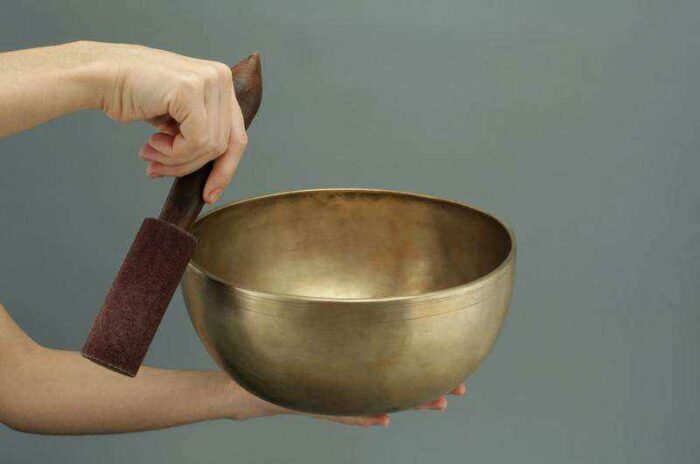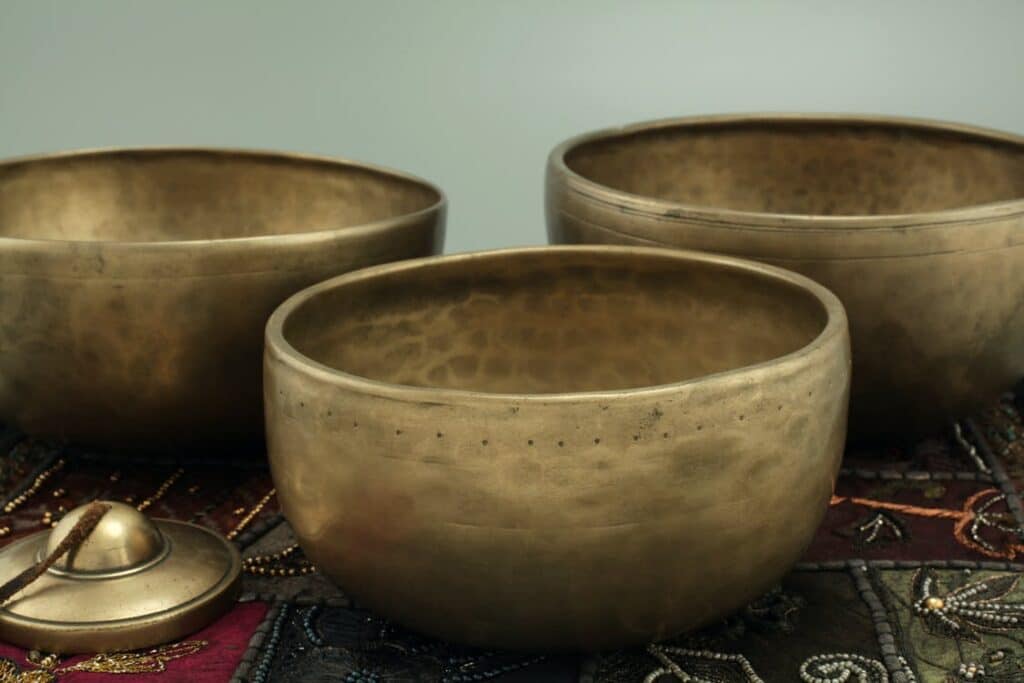
Singing bowls have been around for thousands of years; they are known for their unique sound, which continues to float for long periods after being played. They are a very common fixture in sound healing practices.
According to reiki master and sound healer Susy Schieffelin, they are popular in sound healing because their unique vibrations “can shift energy, clear blockages, and restore the mind, body, and spirit to a balanced state.”
Like all musical instruments, they depend on fiction and vibration to produce the magical sound we hear. They are unique because they can produce different sounds depending on the quality of the material and the conditions under which they are used.
You may have been struggling to find calmness. You might have tried other means or even heard about it, and you do not know how it works. This article will introduce you to everything you need to know, which includes:
- How do they work?
- How do they affect our bodies?
- How to use them?
- Frequently asked questions
How do singing bowls work?
The first step to creating sound is to use a mallet. Science Made Simple UK explained that friction is created by striking the bowl or rubbing it, generating vibrations. These vibrations produce the sound we hear when we hold it.
Continuous rubbing of the rim keeps the sound going. The phenomenon is “Resonance”, and resonance is the note we keep hearing even after we stop rubbing the rim.
The note we hear may differ because the material used in making the bowl can impact the sound. Most of them are made from a bronze alloy of copper, tin, zinc, gold, silver, or even nickel, all of which can affect sound.
Those made out of crystals will not sound like the ones made from a bronze alloy. Wooden mallets will produce a different sound from padded mallets. Size, shape, and weight also impact the sounds being produced.
Finally, the addition of water will change its note, as water is more difficult to vibrate than the air inside an empty bowl.
How does it affect our body and have emotional effects?
While the soothing sounds can calm you down, they might also be a source of curiosity as to how it affects our body. The benefits have been proven by research, which is why they are widely used by people for their mental and physical well-being.
Here is a list of benefits of bowl therapies according to many health studies
- They have been used for deep relaxation because the sound wave patterns are the same as the alpha waves produced by our brain to promote meditation and calm consciousness.
- To relieve pains in the muscle, joints, and shoulders, ease pain related to sciatica, digestive system, headaches, and migraine or spine injuries.
- It improves blood circulation in the body.
- It aids digestion.
- Its high frequency can reach your innermost essence, which boosts your energy and vibrational level giving you the strength you need for your everyday life.
- It helps in the elimination of toxins from the body.
- Relaxing with it improves your concentration, and every emotional tension and blockage is eased.
- The sound with its vibration can release and activate your inner feelings.
- It eases every mental or emotional pain you might be experiencing, such as fear, anger, anxiety, depression, insomnia, etc.
- It inspires creative thoughts within you.
- It increases focus and memory retention.
- It decreases your heart rate and helps to lower your blood pressure.
- It generally stimulates the immune system by producing beneficial changes in brain waves.
How to use the Tibetan singing bowl?

If you are new to this practice and you don’t know how to get started, here is a systematic guide on how to get started.
- Find a peaceful place to relax without disturbances. Put your phone on airplane mode and decide on the amount of time you want to dedicate to this experience.
- Place the bowl on the palm of your hand, or have it positioned on the floor. You can also place it on a cushion to keep the vibrations from affecting other surfaces.
- Hold the mallet in your other hand as if you were holding a pen.
- You can begin by chiming the bowl with your mallet, i.e. tapping it on the edge until you hear the sound sing out.
- Apply a little pressure at first- you do not want to go too hard with the mallet.
- You can also swirl the mallet around the rim but ensure to keep contact between the mallet and the bowl as the sounds slowly build.
- Later, you can try harder strikes, but you do not necessarily want to hit with full force.
- Allow the sound to ring freely, and take moments to breathe deeply as you listen to the sound.
Note any physical or mental shifts you have felt at the end. Do you feel lighter? Do you feel more positive?
If your answer is ‘yes’, make sure to practice again because slowly, you will realize which areas and pressures cause the sounds that are most pleasing to you, and over time you learn to gravitate towards them.
Things to note while using a singing bowl as a tool of sound therapy
- Do not get too close to the instrument: It can damage your hearing and shock your central nervous system.
- If you are a sensitive person, ensure you do not lie too close to it, as the sound can feel intense and overwhelming.
- Ensure you pay attention to your body; if something does not feel right, you need to adjust your position.
- Listening to a singing bowl is safe if you are pregnant but ensure you lie in a safe position for your baby.
- If you have a pacemaker, ensure you have your doctor’s permission and guidance on safeties of using metal singing bowls.
- Finally, talk to your doctor if you are unsure about anything.
Frequently Asked Questions
What to look out for when making a purchase decision?
Choosing a bowl can be overwhelming as its different types and sizes are available for purchase in the market and online. I have created this guide to help you make the best choice based on your specific needs and preferences.
How to Buy?
If you want to buy authentic antiques, you must remember that there are fakes everywhere. To purchase the original one, there are specific markers to look out for;
- Authentic ones will have markings inside and outside of the bowls.
- The bottom will be thinner.
- They may come with a certificate to show that it was certified, and it might cost more than $100 for a small bowl.
- Antiques are made of high-quality metals, and the newer ones can be made of a type of bronze known as “bell metal”, which is made of copper and tin.
Mallets
Mallets can come in various sizes and weights. The most popular materials are suede, wood, etc. Make sure the set comes with a suitable mallet.
Sound Quality
Do not choose based on the image you see alone. Make sure you know what it sounds like before purchasing it. To be sure, the best ones have rich and resonant sounds.
A good type must be able to hold its sound; even the good cheap ones should hold their sound. If it does not, it was poorly constructed, and you should not buy it.
Also, if you are buying online, ensure you read the reviews of customers who had previously purchased the same bowl.
Comparison of Crystal and Metal Type
Many arguments have been on which is the best: crystal or metal type. The argument is that the sound of the metal bowls does not penetrate the body, unlike the crystal bowls, because the human body is crystalline in structure.
You can add both to your list because of the different tones they emit; these variations can help lengthen your meditation or you may use them interchangeably throughout your routine.
Does Size Matter?
When you want to make a purchase you will realize that there are various sizes and shapes available in the market. This might look somewhat confusing because you are unsure which would sound better, the small or the large-sized bowls.
The small ones are not inferior in sound and volume because of their size. They can go anywhere with you because they are very portable and can be carried around easily. You can play it on the palm of your hand, and they tend to “shimmer” as they sing, which makes it fit for therapeutic application.
Large bowls can be very big in the past, but now they can be a few feet in size. They are not as portable as the small ones, but the sound from them is an experience you will love to share with others. The larger size means, the more powerful the sound and vibration, which tend to have a greater impact on the room.
With so many excellent qualities out there, you should choose the one that fits your preference. I would advise a small to medium-sized bowl for beginners; the larger ones would be more suited for advanced users.
Where to Shop?
They can be found in several places such as:
- Online retailers
- Meditation centers
- Yoga studios
- Music shops, etc.
Do Singing Bowls Work?
The majority of people who believe they worked believe the vibrations cause the brain to produce theta waves. These brainwaves are associated with deep relaxation, creativity, and subconscious training. Therefore, listening to them can help your brain attain a more peaceful state.
Why Do Singing Bowls Give Me Headache and Pain?
Like many objects out there that produce sound, they can cause a headache if:
- You are too close to them
- You use them too often
- You are generally prone to headaches
Conclusion
Thanks to the many properties of Tibetan bowls, their healing sounds, and the proven records of their beneficial effects, singing bowl meditations have found a prestigious place in the meditation world as a healing practice today.




